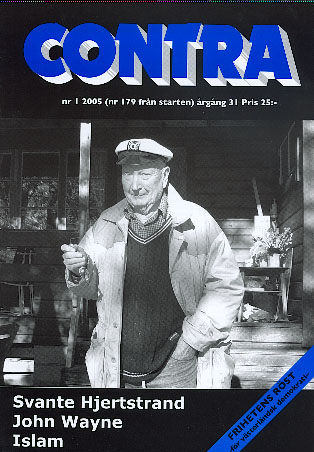
Arguments against the left
– interview with
Svante Hjertstrand
When the first issue of Contra was launched in 1975 there already was a similar journal called “Argument för frihet och rätt” (“Arguments for freedom and justice”). Argument certainly had a more simple technical format than Contra, but reached close to 30,000 copies at its peak. Close to half of these were addressed and distributed by mail, while the rest were sold in the streets or distributed to groups. The larger part of the circulation was free, but the number of paying subscribers reached several thousand.
Editor and publisher of Argument was Svante Hjertstrand, with a Masters degree in Engineering Sciences. Contra has visited Mr Hjertstrand who at 85 leads a very active life in the archipelago of Stockholm, where he lives together with his wife. Often you still see letters to the publisher in major Swedish newspapers, signed by Svante Hjertstrand.
The economy and anatomy of the unholy war
New book by Loretta Napoleoni
Loretta Napoleoni started to collect material to her book on the economics of terrorism several years before 9-11. When the book was published a lot later, the international interest was intensive.
One of the interesting topics discussed in Ms Napoleoni’s book is the operations of PLO and other paramilitary groups during their destruction of Lebanon and its capital Beirut. Part of the operations consisted of bank robberies, fully in the path of Joseph Stalin. Napoleoni chooses the headline ”Privatization of terror” to describe these operations.
al-Qaeda – a business for the wealthy
by Fredrik Runebert
The American journalist Peter L. Bergen is specialized on terrorism. He has tried to follow Osama bin Laden and his network al-Qaeda. The first edition of Holy war Inc. was published shortly after 9-11. He had collected a lot of information already before the attack and he had, on behalf of CNN, interviewed Osama bin Laden himself.
The majority of those active in the al-Qaeda network come from the middle or upper classes and are well-educated. Poverty is no driving force. If poverty had been significant for the rise of terrorism we would have seen it in Africa. But terrorism grew mainly among wealthy young Saudis, who were constituting the bulk of those that committed the atrocities of 9–11.
Stalin and Mao wanted to assasinate John Wayne
by Tommy Hansson
Hollywood is not well-known for the many anti-communist or conservative personalities. On the contrary actors and actresses have often been liberal radicals, though more often in an effort to be politically correct, than because of conviction in attitudes. An exception to the rule was John Wayne, a brilliant actor and ideologically conscious conservative, which made him hated in the Kremlin. Both Stalin and Mao planned assasination attempts against John Wayne.
A bad translation of the Lord’s prayer
by David Stavenheim
The new translation in Swedish of the Lord’s prayer is bad. It was criticised in connection with the new Swedish New Testament published in 1981, but it was still kept in its old form in the Hymn and Prayer Book of the Church of Sweden. Now this has unfortunately been changed.
Odd book on Finland’s greatest
According to a recent poll the greatest man o Finland through the ages was Marshal Carl Gustaf Mannerheim. An odd book on Marshal Mannerheim is based on what is claimed to be years of research. But it turns out that the author, Erkki Hautamäki, is not able to substantiate the cintents of his sources. He claims that his book is based on the secret file S-32, which since long has disappeared in Finnish archives. He claims that there was not only the secret Molotov-Ribbentrop pact, but also a secret pact between the West and the Soviet Union, making Adolf Hitler a mere pawn in the great game. The story is hard to believe. And file S-32 is not shown.
Feminists, communists and suffragettes
by Fredrik Runebert
Kate Weigand is an archivist at the Sophia Smith Collection of Smith College and is teaching history as well as the history of women in the US. In her book Red Feminism she describes a development that has not been very noticed. The development from Communism in the 1910s to feminism in the 1960s.
The most common way to describe feminism is to show its three waves. The first is the fight of the suffragettes to get the suffrage of women. The second wave is the radical feminism and separatism of the 1960s and the third the fundamentalism of identity, claiming that men and women are exactly equal and that there are no biological differences.

